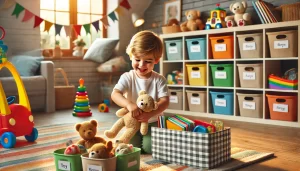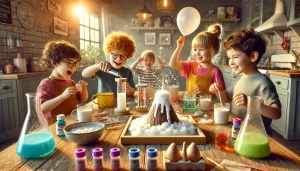Introducing science to young children can be an exciting and hands-on experience. Simple experiments help develop curiosity, critical thinking, and problem-solving skills. Best of all, they make learning fun! You don’t need a fancy lab—just a few household items and a little enthusiasm.
In this post, we’ll explore easy and engaging science experiments that you can do at home with young children. These activities will spark their interest in science while teaching basic concepts in a fun and interactive way.
Magic Milk Experiment
This colorful experiment teaches children about surface tension and chemical reactions.
What You Need:
- A shallow dish
- Whole milk
- Food coloring (various colors)
- Dish soap
- A cotton swab
How to Do It:
- Pour a thin layer of milk into the dish.
- Add a few drops of different food coloring into the milk.
- Dip the cotton swab in dish soap and gently touch the milk’s surface.
- Watch as the colors swirl and mix in beautiful patterns!
What’s Happening?
Milk contains fat molecules. When soap is added, it breaks the surface tension and interacts with the fat, pushing the food coloring in different directions.
Baking Soda and Vinegar Volcano
This classic experiment demonstrates a simple acid-base reaction.
What You Need:
- A small plastic cup
- Baking soda
- Vinegar
- Dish soap (optional)
- Food coloring (optional)
How to Do It:
- Place the cup on a tray or plate to catch spills.
- Fill the cup halfway with baking soda.
- Add a few drops of food coloring and dish soap for extra fizz.
- Pour vinegar into the cup and watch the eruption!
What’s Happening?
When vinegar (acid) mixes with baking soda (base), they create carbon dioxide gas, which causes the foamy eruption.
Dancing Raisins
This simple experiment demonstrates the effect of carbon dioxide in liquids.
What You Need:
- A clear glass
- Carbonated water (soda or sparkling water)
- Raisins
How to Do It:
- Pour the carbonated water into the glass.
- Drop a few raisins into the glass.
- Observe how the raisins rise and fall like they are dancing!
What’s Happening?
Carbon dioxide bubbles attach to the raisins, making them float. When the bubbles pop, the raisins sink back down.
Walking Water Experiment
This activity teaches children about capillary action.
What You Need:
- Three clear cups
- Water
- Food coloring (two different colors)
- Paper towels
How to Do It:
- Fill two cups with water, leaving the third empty.
- Add a few drops of food coloring to the two filled cups (each cup should have a different color).
- Fold two paper towels and place one end in a colored water cup and the other end in the empty cup. Repeat with the second color.
- Watch as the colors travel through the paper towels and mix in the empty cup!
What’s Happening?
Water moves through the paper towel due to capillary action, allowing colors to mix in the middle cup.
Homemade Butter in a Jar
A delicious way to explore physical changes!
What You Need:
- A small jar with a lid
- Heavy cream
- Salt (optional)
How to Do It:
- Pour heavy cream into the jar, filling it halfway.
- Secure the lid tightly.
- Shake the jar vigorously for about 5-10 minutes.
- After a few minutes, you’ll see butter forming. Drain the liquid and enjoy your homemade butter!
What’s Happening?
The shaking separates fat molecules from the liquid in the cream, eventually forming butter.
Static Balloon and Hair Experiment
A fun way to explore static electricity!
What You Need:
- A balloon
- A piece of paper (optional)
How to Do It:
- Inflate the balloon and tie it.
- Rub the balloon against your hair for 10-15 seconds.
- Hold the balloon near small pieces of paper and watch them stick!
What’s Happening?
Rubbing the balloon transfers electrons to it, creating static electricity. This attracts small objects like paper.
Egg in a Bottle Experiment
This experiment teaches about air pressure.
What You Need:
- A peeled boiled egg
- A glass bottle with an opening slightly smaller than the egg
- A small piece of paper
- A lighter (adult supervision required)
How to Do It:
- Light the paper and drop it into the bottle.
- Quickly place the boiled egg on top of the bottle’s opening.
- Watch as the egg is sucked into the bottle!
What’s Happening?
The flame heats the air inside the bottle. When the flame goes out, the air cools and creates a vacuum, pulling the egg inside.
Rainbow in a Jar
A beautiful way to learn about density!
What You Need:
- A clear glass or jar
- Honey
- Dish soap
- Water
- Vegetable oil
- Food coloring
How to Do It:
- Pour honey into the jar first.
- Carefully add dish soap.
- Mix food coloring into water and slowly pour it in.
- Lastly, add vegetable oil.
What’s Happening?
Each liquid has a different density, preventing them from mixing and creating distinct layers.
Final Thoughts
Science doesn’t have to be complicated! These simple experiments are a great way to introduce young children to scientific concepts while having fun. By exploring chemistry, physics, and biology in an engaging way, you’ll nurture their natural curiosity and love for learning.
Encourage children to ask questions, predict outcomes, and discuss what they observe. The more they explore, the more they will learn!
Would you like more ideas for at-home activities? Let me know in the comments!




